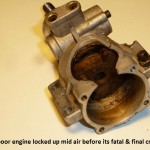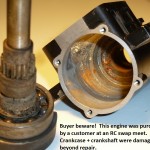The Care and Feeding of Your R/C Engine — Both Glow and Gas
GLOW Engines
Always use fresh fuel from a major supplier. Any fuel left exposed to the air for even just a couple of days is probably ruined and will greatly increase rust and corrosion inside your engine.
.
Here is a breakdown of the damaging effects that glow fuel has on your model airplane engines:
1. Methanol is hygroscopic, meaning that it readily absorbs water from the air.
2. Nitric acid is a main ingredient of nitromethane and it is a highly corrosive mineral acid.
3. Nitromethane is classified as an oxidizer in the presence of water and oxygen. The bottom line is that it works to change the state of steel and aluminum (rust and corrosion).
Q: What Can You Do To Reduce These Damaging Effects?
A: Your best defense against the destructive oxidizing process is to run your engine dry at the end of the day, pull the fuel feed line from the carb, and attempt to start with the glow driver attached. Then add several drops of quality after-run oil into the open carb and turn the engine over several more times without the glow driver attached.
GAS Engines
Gas engines are not immune from the damaging effects of the fuel they burn. Pump gas from the corner station starts out with as much as 10% ethanol alcohol (soon to be 15%) before it is stored in underground holding tanks. I have had gasoline lab tested, and the results have shown as much as 18% ethanol content!
The bottom line of this fuel is:
1. Loss of engine performance. Watered down gasoline is less volatile (lower BTU rating)
2. The alcohol-laden fuel left in your Walbro™ or similar pumper carbs is eating them alive: it attacks the finely-machined surfaces and passages, as well as the internal diaphragms, valves, and gaskets.
Q: What Can You Do To Reduce These Damaging Effects?
A: Run $10/gallon non-alcohol laced gas (groan). Maybe some guys will, wanting the most power from their engines. But you can do what all IndyCar and NASCAR teams do, as they must run a high methanol or ethanol-content fuel: they “pickle” their engines with zero-alcohol-content fuel at the end of each day. You will never see this done on TV. They have tee fittings on the engine fuel supply line onto which they attach a small secondary fuel system with “good” gas and then run their engines long enough to run out the alcohol blend. This is to prevent fuel system and engine component rust and corrosion. You may consider this pickling process for your engines to reduce your fuel costs, as a gallon of alcohol-free gas will go a long way in accomplishing the safe storage of your engine.


